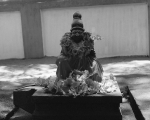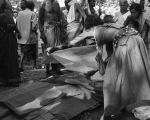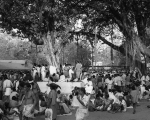Approximately in the 3rd century BCE, a cultural collective was formed in Tamilakam (present-day Tamil Nadu, Kerala, parts of Karnataka, Puducherry, Andhra Pradesh, Lakshadweep and northern Sri Lanka) to record and commit to writing the works of poets and composers which had so far been preserved only in collective memory and oral recitations. This period—3rd century BCE to 3rd century CE—saw much growth in the socio-political sphere when maritime trade and cultural exchange with other regions in India and Southeast Asia was at its peak; influence of this can be seen in the art, architecture and literature of these regions till date. Historians classify this period as the Tamil Sangam period, and the literature composed/compiled during this period is called as Sangam literature.
One of the notable outputs of Sangam literature was the epic poem Silappathikaram (Chilambu+Adhikaram, meaning the story of the anklet), believed to have been written during the rule of the Chera king Senguttavan by his younger brother, the prince-turned-Jain-poet Ilango Adigal. Adigal provides vivid descriptions of the land, landscape, people, flora and fauna, ruling dynasties, culture, religion, festivals, rituals and lifestyle of that era. At a time when it was customary to make a male patron the hero, Ilango created the legendary character of Kannaki, the central figure of Silappathikaram. Interestingly, the epic is also similar in style and content to Greek tragedies.
In the epic, Kannaki is a devoted wife, who lives with her husband Kovalan in Poompuhar, a major trading port in the Kaveri delta. As Kovalan goes bankrupt following an affair with a courtesan, the couple shifts to Madurai (the capital of the Pandyan kingdom). There, while trying to sell one of Kannaki’s anklets, Kovalan gets falsely implicated for the theft of a similar looking anklet belonging to the Pandyan queen. On order of the king, he is immediately executed without a fair trial. On hearing the news, Kannaki storms into the Pandyan court, and reveals the difference between the two anklets—hers and the queen’s—proving that her husband was innocent. Enraged by the injustice, she curses the king, and, as an act of revenge, cuts her left breast and throws it at the palace, which triggers a fire that engulfs the whole city. Her anger is placated by the intervention of Meenakshi, the patron goddess of Madurai, and Kannaki attains salvation. Since the Sangam period, Kannaki has been an icon in the Tamilakam region, where she is revered for her chastity and virtue.
In the epic, Adigalar mentions that the Kuravas (mountain people) see Kannaki under a kino tree in the Chera land and report it to the Chera king Senguttuvan, who is said to have built a temple in honour of Kannaki. Folklore traditions claim that the sacred grove in Kodangallur (approximately 10 km from the ancient seaport Muchiri and the capital of the early Cheras) is the one that was built by Senguttuvan as a continuation of the mother goddess worship. The Bharani festival hosted annually at the Kodangallur Bhagavathy Kavu (kavu meaning sacred grove) venerates the mother goddess and is marked by rituals of fertility and frenzied dance by female and male oracles. There is no archaeological evidence to prove that this was the temple constructed by Senguttuvan and there are several other versions of mythical and mythological stories developed around the temple and its deity. In one of the versions, it is said that the celebrations commemorate the fight between the goddess Kali and the demon Darika. The Bhadrakali worshipped at the Kodangallur Bhagavathy Kavu is considered to be a fierce (ugra) form of the primordial mother goddess. In ancient times, the mother goddess worshipped here was known as Kotravai, and, eventually, many different mother goddess figures merged and overlapped—including Durga, Kannaki, Kali, etc.
The practice of mother goddess worship was common to Tamilakam and Afro-Arabia, and until recently in history, many other cultures across the world practised rituals that involved self-sacrifice, suffering, etc. Kannaki’s integration with the older mother goddess cult resulted in Silappathikaram gaining popularity amongst the masses. Since 1999, photographer Abul Kalam Azad has been creating contemporary visuals of the places mentioned in Silappathikaram. His interest is in the people mentioned in the epic, their lifestyle and rituals, maritime trade and landscape, keeping the classical Tamil text as a reference point. The still-continuing primordial mother goddess worship became the starting point for his body of work titled ‘Story of Love, Desire and Agony’. This series titled ‘Black Mother’ was shot during the Meena Bharani festival at Kodangallur Bhagavathy Kavu in 1999–2000.
A search for the archetypal mother image spanning centuries, this series has been lauded for its nuanced approach. Artist and independent writer Kabita Mukhopadhyay stresses that the point of the series is ‘to encounter the reality in the primordial nature of this pre-historic popular icon that is Mother, within the context of time within.’ In Azad’s work, she goes on to add, ‘the biological ancientness boils into the blackness of the photographs, exploring the utmost human possibility of the medium of photography. The black here ceases to remain a color in order to become the darkness of the Garbha Greeha, the womb.’
Caption text credit: Dr Adarsh C.

















